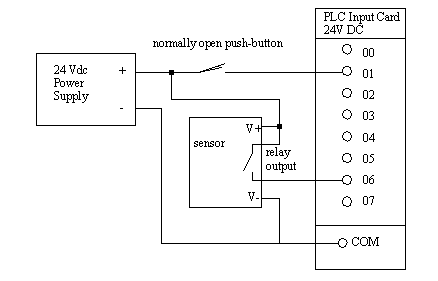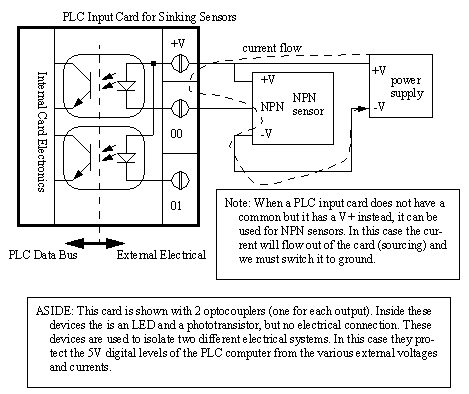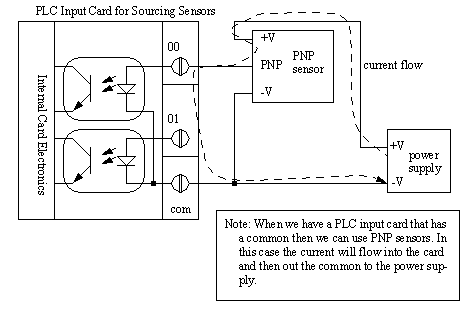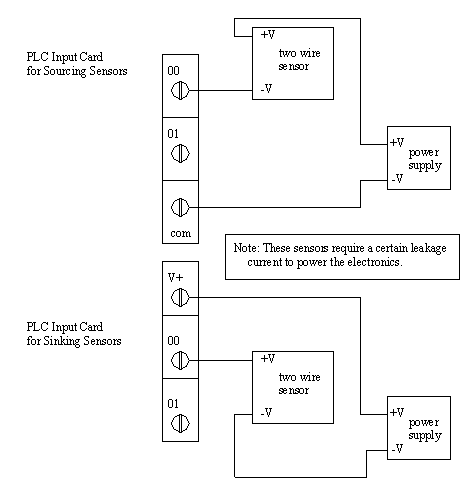10.2.2 Transistor Transistor Logic (TTL)
Transistor-Transistor Logic (TTL) is based on two voltage levels, 0V for false and 5V for true. The voltages can actually be slightly larger than 0V, or lower than 5V and still be detected correctly. This method is very susceptible to electrical noise on the factory floor, and should only be used when necessary. TTL outputs are common on electronic devices and computers, and will be necessary sometimes. When connecting to other devices simple circuits can be used to improve the signal, such as the Schmitt trigger in Figure 10.41 A Schmitt Trigger.
Figure 10.41 A Schmitt Trigger
A Schmitt trigger will receive an input voltage between 0-5V and convert it to 0V or 5V. If the voltage is in an ambiguous range, about 1.5-3.5V it will be ignored.
If a sensor has a TTL output the PLC must use a TTL input card to read the values. If the TTL sensor is being used for other applications it should be noted that the maximum current output is normally about 20mA.
10.2.3 Sinking/Sourcing
Sinking sensors allow current to flow into the sensor to the voltage common, while sourcing sensors allow current to flow out of the sensor from a positive source. For both of these methods the emphasis is on current flow, not voltage. By using current flow, instead of voltage, many of the electrical noise problems are reduced.
When discussing sourcing and sinking we are referring to the output of the sensor that is acting like a switch. In fact the output of the sensor is normally a transistor, that will act like a switch (with some voltage loss). A PNP transistor is used for the sourcing output, and an NPN transistor is used for the sinking input. When discussing these sensors the term sourcing is often interchanged with PNP, and sinking with NPN. A simplified example of a sinking output sensor is shown in Figure 10.42 A Simplified NPN/Sinking Sensor. The sensor will have some part that deals with detection, this is on the left. The sensor needs a voltage supply to operate, so a voltage supply is needed for the sensor. If the sensor has detected some phenomenon then it will trigger the active line. The active line is directly connected to an NPN transistor. (Note: for an NPN transistor the arrow always points away from the center.) If the voltage to the transistor on the active line is 0V, then the transistor will not allow current to flow into the sensor. If the voltage on the active line becomes larger (say 12V) then the transistor will switch on and allow current to flow into the sensor to the common.
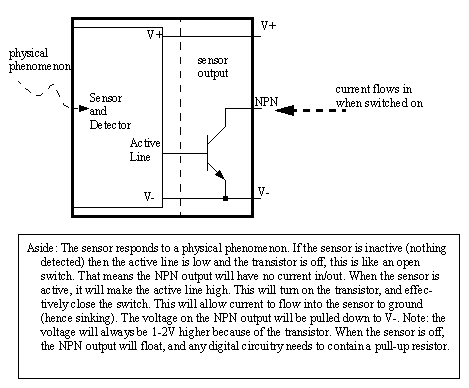
Figure 10.42 A Simplified NPN/Sinking Sensor
Sourcing sensors are the complement to sinking sensors. The sourcing sensors use a PNP transistor, as shown in Figure 10.43 A Simplified Sourcing/PNP Sensor. (Note: PNP transistors are always drawn with the arrow pointing to the center.) When the sensor is inactive the active line stays at the V+ value, and the transistor stays switched off. When the sensor becomes active the active line will be made 0V, and the transistor will allow current to flow out of the sensor.
Figure 10.43 A Simplified Sourcing/PNP Sensor
Most NPN/PNP sensors are capable of handling currents up to a few amps, and they can be used to switch loads directly. (Note: always check the documentation for rated voltages and currents.) An example using sourcing and sinking sensors to control lights is shown in Figure 10.44 Direct Control Using NPN/PNP Sensors. (Note: This example could be for a motion detector that turns on lights in dark hallways.)
Figure 10.44 Direct Control Using NPN/PNP Sensors
In the sinking system in Figure 10.44 Direct Control Using NPN/PNP Sensors the light has V+ applied to one side. The other side is connected to the NPN output of the sensor. When the sensor turns on the current will be able to flow through the light, into the output to V- common. (Note: Yes, the current will be allowed to flow into the output for an NPN sensor.) In the sourcing arrangement the light will turn on when the output becomes active, allowing current to flow from the V+, thought the sensor, the light and to V- (the common).
At this point it is worth stating the obvious - The output of a sensor will be an input for a PLC. And, as we saw with the NPN sensor, this does not necessarily indicate where current is flowing. There are two viable approaches for connecting sensors to PLCs. The first is to always use PNP sensors and normal voltage input cards. The second option is to purchase input cards specifically designed for sourcing or sinking sensors. An example of a PLC card for sinking sensors is shown in Figure 10.45 A PLC Input Card for Sinking Sensors.
Figure 10.45 A PLC Input Card for Sinking Sensors
The dashed line in the figure represents the circuit, or current flow path when the sensor is active. This path enters the PLC input card first at a V+ terminal (Note: there is no common on this card) and flows through an optocoupler. This current will use light to turn on a phototransistor to tell the computer in the PLC the input current is flowing. The current then leaves the card at input 00 and passes through the sensor to V-. When the sensor is inactive the current will not flow, and the light in the optocoupler will be off. The optocoupler is used to help protect the PLC from electrical problems outside the PLC.
The input cards for PNP sensors are similar to the NPN cards, as shown in Figure 10.46 PLC Input Card for Sourcing Sensors.
Figure 10.46 PLC Input Card for Sourcing Sensors
The current flow loop for an active sensor is shown with a dashed line. Following the path of the current we see that it begins at the V+, passes through the sensor, in the input 00, through the optocoupler, out the common and to the V-.
Wiring is a major concern with PLC applications, so to reduce the total number of wires, two wire sensors have become popular. But, by integrating three wires worth of function into two, we now couple the power supply and sensing functions into one. Two wire sensors are shown in Figure 10.47 Two Wire Sensors.
Figure 10.47 Two Wire Sensors
A two wire sensor can be used as either a sourcing or sinking input. In both of these arrangements the sensor will require a small amount of current to power the sensor, but when active it will allow more current to flow. This requires input cards that will allow a small amount of current to flow (called the leakage current), but also be able to detect when the current has exceeded a given value.
When purchasing sensors and input cards there are some important considerations. Most modern sensors have both PNP and NPN outputs, although if the choice is not available, PNP is the more popular choice. PLC cards can be confusing to buy, as each vendor refers to the cards differently. To avoid problems, look to see if the card is specifically for sinking or sourcing sensors, or look for a V+ (sinking) or COM (sourcing). Some vendors also sell cards that will allow you to have NPN and PNP inputs mixed on the same card.
When drawing wiring diagrams the symbols in Figure 10.48 Sourcing and Sinking Schematic Symbols are used for sinking and sourcing proximity sensors. Notice that in the sinking sensor when the switch closes (moves up to the terminal) it contacts the common. Closing the switch in the sourcing sensor connects the output to the V+. On the physical sensor the wires are color coded as indicated in the diagram. The brown wire is positive, the blue wire is negative and the output is white for sinking and black for sourcing. The outside shape of the sensor may change for other devices, such as photo sensors which are often shown as round circles.
Figure 10.48 Sourcing and Sinking Schematic Symbols
